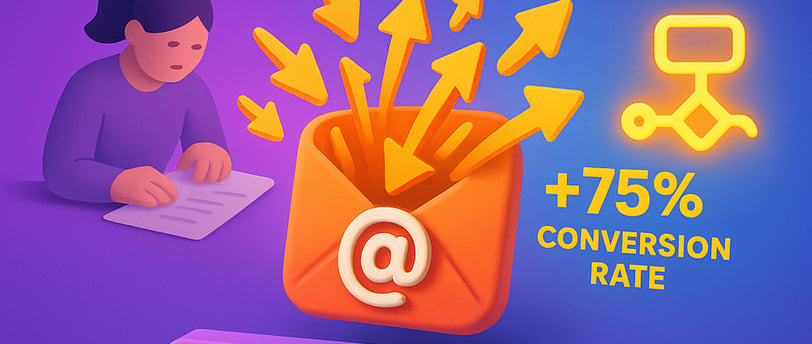Email Marketing Automation: How to Nurture Leads and Increase Conversions
Learn how to use email marketing automation to nurture leads, build relationships, and increase conversions for your business.
MARKETING AUTOMATION
6/5/20253 min read


Introduction
Email marketing remains one of the most effective ways to nurture leads and drive conversions. However, manually managing email campaigns can be time-consuming and inefficient. This is where email marketing automation comes in.
By automating your email campaigns, you can deliver personalized, timely, and relevant messages to your audience, nurturing them through the buyer’s journey and increasing the likelihood of conversions. In this article, we’ll explore how to use email marketing automation to nurture leads and provide actionable tips to help you get started.
What is Email Marketing Automation?
What It Is: Using software to automate the sending of emails based on user behavior, preferences, or triggers.
Why It Matters: Automation saves time, ensures consistency, and allows for personalized communication at scale.
Examples of Email Marketing Automation:
Welcome emails for new subscribers.
Abandoned cart reminders.
Drip campaigns to nurture leads over time.
Benefits of Email Marketing Automation
Here’s why email marketing automation is a game-changer for businesses:
Increased Efficiency: Automate repetitive tasks to focus on strategic activities.
Improved Personalization: Deliver tailored messages based on user behavior and preferences.
Higher Conversions: Nurture leads and recover lost sales with automated workflows.
Better ROI: Maximize the impact of your email marketing efforts with data-driven automation.
Step 1: Segment Your Audience
What It Is: Dividing your email list into groups based on behavior, demographics, or preferences.
Why It Matters: Segmentation allows for more personalized and effective email campaigns.
How to Implement:
Use data from your CRM, website analytics, or email campaigns.
Create segments like “First-Time Visitors,” “Repeat Customers,” or “Cart Abandoners.”
Tailor your messaging and offers to each segment.
Pro Tip: Use dynamic content in emails to personalize messages further.
Step 2: Create a Welcome Series
What It Is: A series of automated emails sent to new subscribers to introduce your brand and build trust.
Why It Matters: Welcome emails have high open rates and set the tone for future interactions.
How to Implement:
Send a thank-you email immediately after sign-up.
Introduce your brand, products, or services in subsequent emails.
Include a clear CTA to encourage engagement (e.g., “Shop Now” or “Learn More”).
Pro Tip: Use a friendly, conversational tone to make your welcome emails more engaging.
Step 3: Set Up Abandoned Cart Emails
What It Is: Automatically reminding customers who leave items in their cart without purchasing.
Why It Matters: Abandoned cart emails can recover up to 30% of lost sales.
How to Implement:
Set up automated emails that trigger when a cart is abandoned.
Include product images, a clear CTA, and a sense of urgency (e.g., “Your cart is expiring soon!”).
Offer incentives like discounts or free shipping to encourage completion.
Pro Tip: Test different email timings and messaging to optimize recovery rates.
Step 4: Build Drip Campaigns
What It Is: A series of automated emails sent over time to nurture leads and guide them through the buyer’s journey.
Why It Matters: Drip campaigns keep your brand top of mind and increase the likelihood of conversions.
How to Implement:
Create a sequence of emails that educate leads about your products or services.
Include valuable content like eBooks, webinars, or case studies.
Use lead scoring to prioritize high-value prospects.
Pro Tip: Use tools like ActiveCampaign or Marketo for advanced drip campaign features.
Step 5: Automate Post-Purchase Follow-Ups
What It Is: Sending automated emails after a purchase to build loyalty and encourage repeat business.
Why It Matters: Engaged customers are more likely to make repeat purchases and recommend your brand.
How to Implement:
Send thank-you emails with order details and delivery updates.
Request reviews or feedback to build social proof.
Offer exclusive discounts or rewards for future purchases.
Pro Tip: Use automation to upsell or cross-sell related products after a purchase.
Step 6: Measure and Optimize
What It Is: Tracking the performance of your email campaigns and making improvements.
Why It Matters: Continuous optimization ensures your email marketing strategies remain effective.
How to Implement:
Use analytics tools to track key metrics like open rates, click-through rates, and conversions.
A/B test different elements of your campaigns (e.g., subject lines, CTAs, visuals).
Regularly review and update your automation workflows.
Pro Tip: Set up dashboards to monitor performance in real-time.
Real-World Example: How Automation Boosted Conversions
Let’s look at a real-world example of how email marketing automation helped a business:
The Problem:
An online retailer struggled with low email engagement and high cart abandonment rates.
The Solution:
They implemented email marketing automation to send personalized emails, recover abandoned carts, and nurture leads.
The Results:
The retailer saw a 35% increase in email open rates and a 25% reduction in cart abandonment.
Conclusion
Email marketing automation is a powerful tool that can transform your business by increasing efficiency, personalizing customer experiences, and driving more conversions. By following these strategies, you can nurture leads, build relationships, and boost your bottom line.
Start automating your email marketing today, and unlock the full potential of your business!
